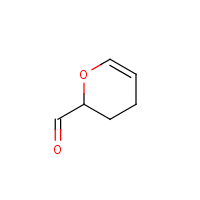2H-Pyran-2-carboxaldehyde, 3,4-dihydro-
Agent Name
2H-Pyran-2-carboxaldehyde, 3,4-dihydro-
Alternative Name
Acrolein dimer
CAS Number
100-73-2
Formula
C6-H8-O2
Major Category
Other Classes

Synonyms
2,3-Dihydro-1,4-pyran-2-karboxaldehyd [Czech]; 2-Formyl-3,4-dihydro-2H-pyran; 2-Propenal dimer; 3,4-Dihydro-2H-pyran-2-carboxaldehyde; 5-Hexenal, 2,6-epoxy-; Pyran aldehyde; Acrolein dimer, stabilized; [ChemIDplus] Acroleine, dimere, stabilise (French DOT); Dimero de la acroleina, estabilizado (Spanish DOT); [CAMEO] UN2607
Category
Other Organic Compounds
Description
Colorless or yellow liquid with a pungent unpleasant odor; [CAMEO] Clear colorless liquid; [Sigma-Aldrich MSDS]
Sources/Uses
Used to make other chemicals and plastics; [CAMEO]
Comments
A mild skin irritant; Causes respiratory depression and lung changes in inhalation lethal-concentration studies of rats; Causes changes in bladder weight, changes in platelet count, and effects on other proteins in 9-day intermittent inhalation studies of rats; [RTECS] May cause eye and mucous membrane irritation; [CAMEO] May polymerize; An irritant that may cause serious eye injury; Harmful by ingestion, inhalation, and skin absorption; Inhalation of high concentrations may cause weakness, dizziness, and unconsciousness; [Sigma-Aldrich MSDS] Acrolein dimer, stabilized (UN2607) has warning of explosive polymerization; [ERG 2016]
Biomedical References
Exposure Assessment
Lethal Concentration
LC50 (rat) = 3,225 ppm/4hr
Explosive Polymerization
Yes
Explanatory Notes
The Guide in the Emergency Response Guidebook is for "Acrolein dimer, stabilized."
NFPA
high ambient temp required
Adverse Effects
Neurotoxin
Other CNS neurotoxin
Diseases, Processes, and Activities Linked to This Agent
Other Information
No other related information on this agent was found.